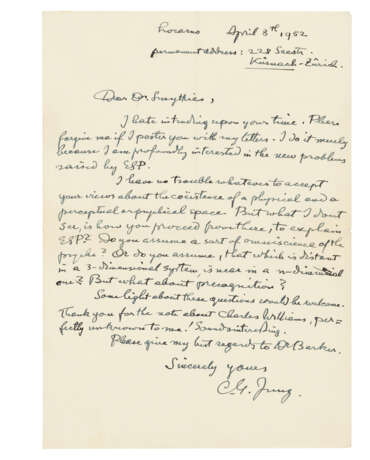ID 1109093
Lot 293 | Carl Jung (1875-1961)
Estimate value
£ 3 000 – 5 000
Autograph letter signed (‘C.G. Jung’) to Dr [John Raymond] Smythies, Locarno, 8 April 1952
In English. One page, 295 x 209mm. Provenance: Sotheby's, 21 November 1989, lot 282.
Synchronicity and grappling with the problems raised by extra-sensory perception. ‘Please forgive me if I pester you with my letters. I do it merely because I am profoundly interested in the new problems raised by ESP. I have no trouble whatever to accept your views about the coexistence [sic] of a physical and a perceptual or psychical space. But what I don’t see is how you proceed from these to explain ESP? Do you assume a sort of omniscience of the psyche? Or do you assume that which is distant in a 3-dimensional system is near in a n-dimensional one? But what about precognition? Some light about these questions would be welcome’. Jung thanks his correspondent for his note about Charles Williams, ‘perfectly unknown to me!’.
Jung turned to parapsychology to build a case for a connection between synchronicity and the paranormal. In the book Synchronicity: An Acausal Connecting Principle, he wrote: ‘It is impossible, with our present resources, to explain ESP, or the fact of meaningful coincidence, as a phenomenon of energy. This makes an end of the causal explanation as well, for "effect" cannot be understood as anything except a phenomenon of energy. Therefore it cannot be a question of cause and effect, but of a falling together in time, a kind of simultaneity. Because of this quality of simultaneity, I have picked on the term "synchronicity" to designate a hypothetical factor equal in rank to causality as a principle of explanation’. John Raymond Smythies (1922-2019) was a British neuropsychiatrist, neuroscientist and neurophilosopher who developed the first specific biochemical theory of schizophrenia; his research was inspired by the remarkable effects of mescaline on the human brain and the interdisciplinary work of Albert Schweitzer. Jung directs his letter to Smythies at the Atkinson Morley Hospital in Wimbledon: founded in 1869, it became one of the most advanced brain surgery centres in the world in the 20th century, and was involved in the development of the CT scanner in the 1970s.
| Artist: | Carl Gustav Jung (1875 - 1961) |
|---|---|
| Place of origin: | Switzerland |
| Artist: | Carl Gustav Jung (1875 - 1961) |
|---|---|
| Place of origin: | Switzerland |
| Address of auction |
CHRISTIE'S 8 King Street, St. James's SW1Y 6QT London United Kingdom | |||||
|---|---|---|---|---|---|---|
| Preview |
| |||||
| Phone | +44 (0)20 7839 9060 | |||||
| Buyer Premium | see on Website | |||||
| Conditions of purchase | Conditions of purchase |











